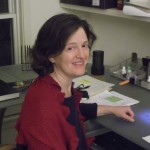 “I am a fertility goddess,” I told Glenn. “First I get pregnant with a woman, then I get pregnant at forty-five.”
“I am a fertility goddess,” I told Glenn. “First I get pregnant with a woman, then I get pregnant at forty-five.”
“Indeed,” Glenn said.
“Yes. If I’d lived my whole adult life with men, and at an earlier time, when they didn’t have such good birth control, I’d have six kids and six abortions behind me by now.” I am a historian of women and sexuality, and such people have no illusions about how women used to control their fertility.
“Good thing Julia saved you from that fate,” Glenn said.
We had some help. When we decided we wanted to have a kid, I said: good, let’s go see our doctors to make sure everything’s in order, check your sperm count, my hormone levels, that kind of stuff.
“I don’t really think that will be necessary,” Glenn said. “I did that before Katrin wanted to get pregnant.” Katrin was an old friend of Glenn’s, with whom he’d shared a long history of sexual tension and a brief romance that remained mainly platonic. By the time she wanted a child, she was with a woman. But Glenn had agreed to help out.
They’d only tried once. Birgit didn’t get pregnant. Then Glenn realized he just wasn’t comfortable with the idea of fathering a kid he wouldn’t help to raise. It had been different for Adam’s father. Tony had figured if Julia and I wanted a kid, we should be able to have a kid, and the moment when a lesbian couple wanted to get pregnant was no time for men suddenly to discover that they couldn’t possibly father children they weren’t prepared to raise. But also: Tony did not want children of his own. He knew he’d feel no desire to parent the child who was biologically his, though he was glad to be friends with him—after all, he was friends with their mothers. We were happy that Adam would know Tony: no adolescent drama of searching for the missing father. But Glenn had always wanted kids. The thought of helping to make one who would then live across the ocean— Katrin and Maria lived in Germany—was too much to bear.
“That was years ago! Get checked again. I don’t want to go through all the stress of trying to get pregnant—timing sex and everything—and have it not work, and then discover there’s something we should have found out about ahead of time.”
Glenn’s sperm count, it turned out, was fine. But his sperm motility wasn’t. His urologist referred us to the reproductive endocrinology clinic. On our first visit, we saw the cover sheet for our file, which read:
“Referring physician: Dr. Moses Wood, Urology. Diagnosis: Unspecified Female Infertility.”
Glenn surely knew what was coming on the drive back home: my rant about how the medical profession pins all fertility problems on the woman. With a referral by a urologist?
Barb, whom I’d been seeing in the Family Practice Clinic for ten years, had run some hormone tests on me and declared I was years away from menopause. I’d already had one baby, the result of exactly two months of trying with Tony. And I figured I had genetics on my side. My mother had managed to get pregnant on every form of birth control in use in the early and midsixties—which, she’d be the first to tell you, had a lot to do with the fact that she wasn’t the most reliable user—but still. She hadn’t hit menopause till her fifties.
In practice, the doctors were more sensible than our intake sheet. If Glenn had low sperm motility, the thing to do was intrauterine insemination, IUI for short. I took the minimum dose of Clomid to make sure I was ovulating, used an ovulation predictor kit (aka a “pee stick”) to see when the egg was about to pop out, and when the pee stick read positive, we went to the clinic. There Glenn “deposited a sample” in the “collection room” (the “masturbatorium” to us), the lab technicians “washed” it (they put it in a solution and then into a centrifuge, which concentrates the perky sperm and leaves behind most of the sluggish ones), and a nurse squirted the washed sperm straight into my uterus with a catheter, saving those lame sperm the effort of swimming through my vagina and cervix to get to my uterus. Glenn got to do his part in a darkened room with a comfy sofa and, if he was so inclined, pornography; I did mine on an examining table under bright lights with my feet in stirrups and a speculum hanging out of me; but there you go. It’s less uncomfortable than a pap smear.
I told Glenn I imagined his sperm hobbling along with walkers, trying to make their way to my old-lady egg with teased white hair and too much lipstick.
It worked. I got pregnant in late January.
 Elizabeth Heineman, 52, is the mother of one stillborn and two surviving children, aged twenty-two and three. She describes herself as raising “two generations of only-children.” Her personal essays on her stillbirth and miscarriage have appeared in many outlets, including salon.com, Hip Mama, The Examined Life Journal and New Millennium Writings. Elizabeth is a professor in the Department of History and the Department of Gender, Women’s, and Sexuality Studies at the University of Iowa. There, she teaches classes on Germany, Europe, gender and sexuality, and the history of human rights.
Elizabeth Heineman, 52, is the mother of one stillborn and two surviving children, aged twenty-two and three. She describes herself as raising “two generations of only-children.” Her personal essays on her stillbirth and miscarriage have appeared in many outlets, including salon.com, Hip Mama, The Examined Life Journal and New Millennium Writings. Elizabeth is a professor in the Department of History and the Department of Gender, Women’s, and Sexuality Studies at the University of Iowa. There, she teaches classes on Germany, Europe, gender and sexuality, and the history of human rights.
Ghostbelly (Feminist Press, 2014) is Elizabeth Heineman’s courageous and deeply intimate memoir of her stillbirth. Despite the tragedy of stillbirth, the memoir also has upbeat moments: her teenaged son’s ability to cheer her up in the darkest of times, her subsequent adoption of a baby, and – in this passage – her joy at becoming pregnant at age 45. You can read more about Ghostbelly here or order it here. Ebook and audiobook editions are also available.
